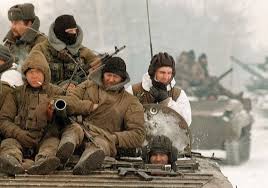Kasvukipuja
| Kasvukipuja | |||||||
|---|---|---|---|---|---|---|---|
 A KjAVH mechanized column in southern Kantemosha | |||||||
| |||||||
| Belligerents | |||||||
|
tbd
| |||||||
| Commanders and leaders | |||||||
|
tbd
|
tbd
| ||||||
| Strength | |||||||
|
tbd
|
tbd
| ||||||
Kasvukipuja (Kantemoshan: "Growth Pains") is the name given to the roughly four year period of violence and unrest immediately following the secession of the Kantemoshan and Ambrazkan territories from Soravia during the Sostava War. The conflict was characterized by many different factions coming forward to fight, either for the independence of certain states for ethnic or political reasons, or to compete for dominance over the entire region. Factions rose and fell about every year, with towns changing hands constantly, some cases seeing towns being taken over by three different opposing factions over the course of a day.
The war itself started out as particularly violent civil unrest in cities after the provisional government was announced to be holding initial elections in March of 1983. Key factions, such as the Socialist State of Miravice (SSoM) and the Socialist State of Pemitovo (SSoP), rose up during this phase of the conflict, with entire provinces or cities being claimed as they seized pre-war militia stockpiles and civilian armaments. The Provisional Government of Kantemosha and Ambrazka (Kantemoshan: Kantemossi ja Ambron väliaikainen hallitus), or KjAVH, moved second-line army units, just arrived from securing the borders and fighting for the regions' secession, to put down these revolts, but low morale and lack of belief in the government, who was then believed to be mostly Soravian oligarchs, caused entire units to surrender their arms, vehicles and themselves to these movements, adding fuel to the flames. Over the course of the four years from that point, the regions of Kantemosha and Ambrazka went ablaze as the KjAVH fought to stabilize the country and preserve their grip on power. For three of the four years, the KjAVH's main rivals, the Kantemoshan People's Liberation Movement (Kantemoshan: Kantemoosinin Kansan Vapautusrintama), KKV, and Ambrazkan Revolutionary Movement (Ambrazkan: Ambrohzkovo revolučné hnutie), ARH, impeded its efforts to stabilize the country, before leadership changes and negotiations caused the three to pursue the same goal and effectively become one.
On the 12th of July, 1987, the Koskunen Concordat was signed by the three parties after the major, jointly-conducted Pähkinä Offensive was undertaken successfully, crushing the Holy Path's Armed Front (Ambrazkan: Ozbrojená Divízia Svätej Cesty), aka OdSC. Coalescing the three movements together into the Federal Government of Kantemosha and Ambrazka, the two independent states of Socialist Miravice and Socialist Pemitovo were coerced into being signatories to the treaty at threat of provincial destruction. Following the treaty, resistance by any remaining factions were brutally crushed by the newly formed armed forces of the Union, and by the 25th of September, Kantemoshan authorities announced that armed hostilities had ceased, marking the end of the conflict.
Origins
Kasvukipuja found it's origins in Soravia's internal struggles during the Sostava War(1979-1983), with corruption and constant power over-reach of the then-current Soravian president, Vilem Gardos. With little power left in the Soravian Duma or Voynaskul, there was little faith in their ability to fix the situation. Dissent grew in the higher echelons of the Soravian military, with the resignation of Sava Tokar, leading general officer of the Soravian Army, seeing outright retaliation and character assassination by Gardos as he took away Tokar's military honours. This fueled dissatisfaction with the government, eventually manifesting into outright mutinies of large portions of the Soravian military. In addition to the opportunistic officers of the Soravian military mutinying against an increasingly dictatorial government, guerilla movements all over the Soravian held territories rose up, such as in Zalykia. Mutinous soldiers and some of these guerilla movements (New Voyin Movement) became collectively known as 'Partisans', whilst loyalist military forces and loyalist militias, fighting in the Presidency's name, fought under the label of 'Constitutionalists'.
As the struggle developed, many constituent republics under Soravian rule at the time saw the opportunity to break free, such as Radushia, Vichod, Vedmed, etc. Among these republics were the two constituent republics of Kantemosha and Ambrazka, that collectively rose up under a single front to push against Soravian units and push them across the old borders. Through popular uprising and military mutinies in these areas by natives, Soravian control was quickly wrestled away as the Presidency found itself stretched thin. Kantemoshan and Ambrazkan soldiers would secure western borders with Soravia by 1982, and for less than a year, were able to rest. Despite this outstanding victory, Kantemosha and Ambrazka had only coalesced in a time of opportunity, with little ideological similarity between many groups. A provisional government consisting of majority Kantemoshans was established as the KjAVH, but scandal immediately arose as a number of these 'ethnic Kantemoshans' and 'ethnic Ambrazkans' were revealed to be Soravian oligarchs, seeking to keep control of their estates by staying with the new government. Other pitfalls of the government included lack of experience in civil management, creating logistical crises that affected the civilian populace, especially for those in Ambrazka who were often the last to receive shipments. This set the stage for the initial stages of Kasvukipuja.